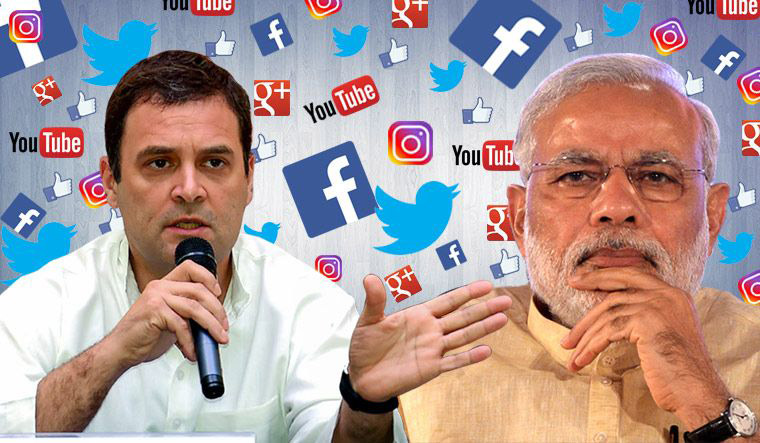When Karnataka assembly election fever gripped the nation, political parties left no stone unturned to ensure they put up their best show. In tune with changing times, the campaign game was played out not just on the streets, but cleverly on a new turf—social media.
What brought home the votes was not persuasive speeches and echoing chants, but two masterminds—Divya Spandana and Amit Malviya—social media heads of two largest stakeholders—Congress and BJP respectively.
In 2014, when the BJP had a landslide victory in the parliamentary elections, the Congress was an amateur in the online game. In May 2017, the Congress stepped up their game and appointed Kannada film actress Divya Spandana with the task of reviving the social media image of the party. What followed in the next 12 months was a revamp—a makeover of the grand old party's public image inside out.
Karnataka was Divya’s first game board. She went ahead and changed the Congress President Rahul Gandhi’s twitter handle from @OfficeOfRG to @RahulGandhi to give it a more personal and intimate appeal. Having got the first move right, she unleashed a flood of trolls, memes and banters at the opposition. From the Congress’ official account (@INCIndia) to Rahul Gandhi’s and her own (@divyaspandana), every social media account became a channel for the strike.
While the BJP used graphs to show the growth under its governance at the Centre, the Congress used interactive versions to cripple the Gujarat model of development under BJP in comparison to the Karnataka model under Congress. While the BJP tweeted “Will Congress President Rahul Gandhi investigate this”, referring to an allegation against P. Chidamabaram, the Congress handle responded with a longer list and the caption “Will the BJP Def. Min get her party president to investigate these?” With hard-hitting and often quirky comebacks, it was a tit-for-tat game on social media
Digging out age-old scams from the opposition party and flaunting their government’s infrastructural developments have always served as classic election campaign techniques. The online platform was not alien to this, but the format was new. While the 2014 elections saw campaigners calling out scams on the streets and television, in 2018, the trigger was in innovative online posters and retweets. However, when it came to infrastructure developments, the style was no longer a list-of-achievements. For instance, the Congress used professional micro-documentaries to review its Tender SURE framework of pedestrian friendly infrastructure in Bengaluru. The breathtaking drone shots well appealed to a young population that has been swept away by adventure cameras such as goPro in recent times.
Another popular social media trend has been the series of 'Expectation Vs Reality' memes. The Congress used a similar technique to call out on the BJP's claims. In a series called 'ModiLies Vs Reality Check', the Congress used a simple two-sided layout to place the prime minister’s false claims next to facts. This saved them the task of tagging the allegations as false and gave room for the public to decide. Later, a public poll that the party put up on twitter asking “what was the most disgraceful tactic used by PM Modi in his Karnataka Elections?” staked majority response for “Blatant Lies”.
A new arena that the Divya Spandana-led Congress took over was trolls—humorous posts equipped to cause critical shame and disgrace. And the Congress used this in every format possible. One of the videos showed a montage of the Prime Minister’s 'blunders'—from mispronouncing Mahatma Gandhi’s name to absurd comments on climate change.
The next target in Divya’s game plan was sexism. A collection of sexist remarks made by various BJP MLAs were combined and was taken out to the streets to ask the public “if that was the people you wanted to govern you” and the response video was posted. For the public, misogyny was the last thing they wanted in an already crumbling social structure.
In an overview, Divya’s entry not only changed the campaign language, but even the tone. From what was once “an aggressive rant” against the opposition, the tone changed to subtle sarcasm and wordplays.
Adding to the fun was former Karnataka Chief Minister Siddaramaiah who wielded the twitter weapon very early on in the high-stakes battle. As the battle gained momentum, Siddaramaiah's point-by-point rebuttal of PM Modi's claims, ensured the message hit straight home. For instance, when Modi challenged Rahul Gandhi to speak for 15 minutes, without the aid of notes, on the development carried out by the Congress in Karnataka, Siddaramaiah counter-challenged him. He tweeted to Modi: “Dear PM @narendramodi ji, I challenge you to speak about the achievements of B S Yeddyurappa’s Govt in Karnataka for 15 minutes by looking at a paper.”
In fact, Yeddyurappa seemed to have an edge over his rival Siddaramaiah due to an almost double the number of followers on social media. The teams that handled the social media handles of both the leaders ensured responses were never too late, and were peppered with wry humour to catch eyeballs. It was interesting to watch old-school politicians upping their game on a modern-day platform. Such is the need of the hour.
The plot was very different in the 2014 parliamentary elections. The two parties were playing on two levels. The BJP almost had a monopoly on social media while the Congress was pretty much confined to old-school campaign techniques that favoured them little. Four years later in Karnataka, the tables have changed. The Congress party has not only matched up to the BJP’s social media standards but has gone ahead to set new yardsticks.
What changed between 2014 and 2018 was not an ideology or fan following, but what many describe as the most pivotal change at the Congress headquarters—a digital warfare.


